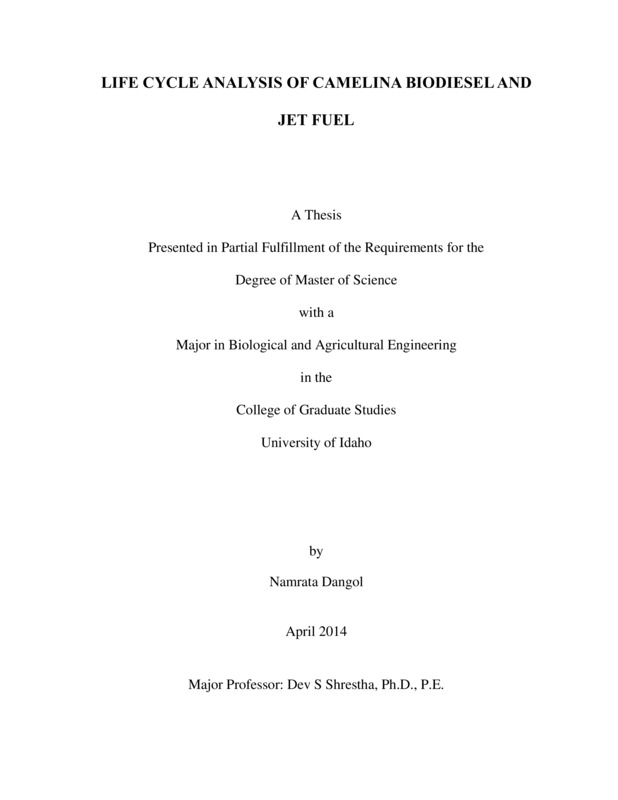Life-cycle analysis of Camelina biodiesel and jet-fuel
Dangol, Namrata. (2014). Life-cycle analysis of Camelina biodiesel and jet-fuel. Theses and Dissertations Collection, University of Idaho Library Digital Collections. https://www.lib.uidaho.edu/digital/etd/items/dangol_idaho_0089m_10155.html
- Title:
- Life-cycle analysis of Camelina biodiesel and jet-fuel
- Author:
- Dangol, Namrata
- Date:
- 2014
- Keywords:
- camelina biodiesel fossil energy ratio Green house gas emission jet-fuel Lifecycle analysis net energy ratio
- Program:
- Biological & Agricultural Engineering
- Subject Category:
- Alternative energy; Environmental engineering
- Abstract:
-
Camelina sativa (Camelina) could be a potential feedstock to help meet the goal of 36 billion gallons of biofuel production in the United States by 2022, as set forth by EISA of 2007. This research is focused on assessing the energy balance and greenhouse gas (GHG) emissions from camelina biodiesel grown and produced in the Pacific Northwest (PNW) region of the USA. Data were collected from a camelina farm in the region and compared to literature values. Energy used in camelina crushing and transesterification were measured at the University of Idaho. Life cycle analysis showed that use of camelina biodiesel reduces GHG emissions by 72% compared to 2005 baseline diesel fuel. Camelina biodiesel at B100 level, however, did not meet the ASTM D6751 specification for oxidative stability without any additives but could be corrected with proper additive. Camelina had a smaller seed size compared to canola and consequently required 23% more energy for crushing. Despite higher energy use for crushing, the net energy ratio for camelina biodiesel was found to be 3.68.
From the agronomic standpoint, camelina can be incorporated as a rotational crop into low rainfall areas of the PNW . Wheat areas of PNW with annual rainfall from 19 to 38 cm (7.5-15") and currently incorporating fallow into their rotations were considered as potential areas for camelina. There were 846,500 hectares (2.1 million acres) of land available in the region that could potentially produce 443.0 million L of biodiesel (117.1 million gal) and 1.2 billion kg of meal per year. This meal quantity is about 12.1% of the potential camelina meal that could be used as livestock feed in the PNW. Therefore, it was concluded that the meal has adequate market to be consumed locally as livestock feed.
This research also conducted the life cycle analysis of camelina jet fuel produced in the laboratory scale facility. The jet fuel was produced via deoxygenation of the camelina oil in an inert environment, in the presence of Pd/Al2O3 catalyst. The jet fuel fraction was separated with fractional distillation. The produced jet fuel was tested for ASTM D-7566-13 specifications for aviation fuel. The produced jet fuel did not meet the specifications for freezing point by 2°C at its neat form with no additives. The energy balance and GHG emission analysis of the produced fuel was performed. The NER of the fuel was found to be 1.36, and the GHG emission reduction was 57% compared to the conventional jet fuel.
- Description:
- masters, M.S., Biological & Agricultural Engineering -- University of Idaho - College of Graduate Studies, 2014
- Major Professor:
- Shrestha, Dev S
- Committee:
- Gerpen, Jon Van; Brown, Jack
- Defense Date:
- 2014
- Identifier:
- Dangol_idaho_0089M_10155
- Type:
- Text
- Format Original:
- Format:
- application/pdf
- Rights:
- In Copyright - Educational Use Permitted. For more information, please contact University of Idaho Library Special Collections and Archives Department at libspec@uidaho.edu.
- Standardized Rights:
- http://rightsstatements.org/vocab/InC-EDU/1.0/

